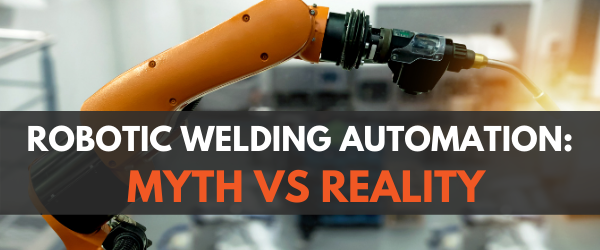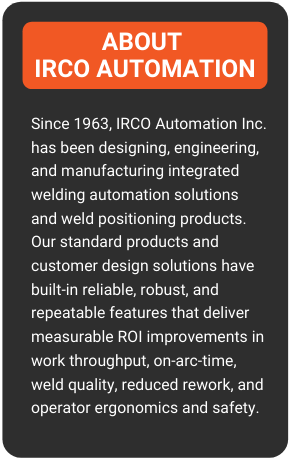A couple months ago, we posted Automated Welding : Myth vs Reality, an article exploring some common misconceptions about Welding Automation. As a follow-up to that post, and by special request, Matt has added to this series and provided us with a narrower look at Robotic Welding Automation: Myth vs Reality. Continue reading below to learn more about some of the misconceptions and facts about Robotic welding automation!
Sections:
-
MYTH #1: Robotic welding eliminates the need for human welders
-
MYTH #2: My positioning equipment is not compatible with robotic weld cells
-
MYTH #3: Robotic automation is unaffordable
-
MYTH #4: Robotic weld cells take up too much space and create numerous safety hazards
-
MYTH #5: All types of welding can be performed robotically
- Or, jump down to the summarized Infographic!
Robotic Welding Systems: Myth vs Reality
It is no secret that there are mixed feelings when Robotic Manufacturing is brought into the conversation. The benefits are undeniable, but at what cost? Whether the concern is financial or based out of luddism, it is always difficult to separate fact from myth. This renders making informed decisions difficult when manufacturers are looking to upgrade or automate their equipment. Robotic integration presents the opportunity for enormous benefits to any fabrication process, but in order to fully appreciate the impact that this type of automation can have on your production, it is first important to separate the facts from the popular skepticisms.
.png?width=2240&name=Welding%20Automation%20improves%20safety%20(2).png)
MYTH #1: Robotic welding eliminates the need for human welders.
Human welders will never go out of style. For unique parts or small-batch runs, nothing matches the flexibility of human intuition. It is easy to associate the implementation of robotic equipment with the replacement of skilled tradesmen, but this is inaccurate for several reasons. While robots are very good at replacing laborious and repetitive movements, there is a serious limit to their ability to adapt and they have next to no improvisation skills. Robots have some adaptability through seam tracking, but it is limited and not intended to overcome unexpected roadblocks. Welding is unique in that components often include complex geometry, varying weld parameter requirements, and unexpected behaviors that require experienced personnel to overcome. For many applications, welding simply does not fall in the category of laborious and repetitive movement.
Considering the above points, it is important to recognize that robots still do have a very important role in welding and fabrication. Robots are a tool for increasing productivity, reducing scrap, minimizing rework, and eliminating human error. A qualified welder’s continual presence is still essential and on its own, a tool is nothing without a competent wielder. Programming a welding robot would simply not be possible without the collaboration of skilled workers, and there is still a constant need for supervising the equipment and ensuring finished products adhere to the highest quality standards and engineering specifications.
.png?width=2240&name=Welding%20Automation%20improves%20safety%20(3).png)
MYTH #2: My positioning equipment is not compatible with robotic weld cells.
Most of IRCO Automation’s line of standard products are separated into two categories: VFD-driven and Robot-Ready. The VFD equipment is designed to be controlled by an operator with a footswitch or pendant, whereas our servo-driven Robot-Ready machines operate with fine-adjustment positional precision and minimal backlash to operate as an external axis on a robot cell. When considering the implementation of robot cells, it is easy to assume that all auxiliary equipment must be replaced with servo-controlled alternatives. This adds to the high capital cost of new equipment and may make the upgrade seem financially unfeasible.
While servo-controlled positioning equipment and robots are a match made in heaven, it is far from impossible to use one without the other. The availability of reasonably priced seam tracking equipment allows robotic applications to work around static parts that may not be in the exact same location at the beginning of every cycle. The only limiting factor here is the reach of the manipulator's arm, which must be adequate to replace the movement of the workpiece. If all joints are reachable for a given manipulator arm at an appropriate torch attitude, there is no reason why the process can’t be done robotically. Ensure your operators are well-trained to place the workpiece within a specified positional tolerance and the seam-tracking will take care of the rest. This will avoid a costly and premature replacement of your existing equipment.
.png?width=2240&name=Welding%20Automation%20improves%20safety%20(4).png)
MYTH #3: Robotic automation is unaffordable
As with any technological advancement, the price inevitably decreases with time. Robotics have been part of the manufacturing industry for decades, and with several large multinational brands to choose from, the time to invest in this type of equipment has simply never been better. This is especially true in light of the recent pandemic that tested manufacturers’ abilities to work short-staffed and evaluate their ability to meet demand in the event that a large portion of their workforce was unavailable. While the up-front price tag is still (and likely always will be) high for new capital equipment, the value of knowing that you will secure in your ability to meet your production targets must be considered against the initial investment.
Additionally, robotic systems add value in other ways by reducing operator exposure to hazards, maximizing the yield of consumables, minimizing scrap, reducing rework, and improving throughput. When considering the price tag of a robotic system, it is critical to consider all of the factors that contribute towards adding value to your operation and offset the capital investment.
As mentioned above, entire stations do not need to be replaced to incorporate robotic welding into your production process. IRCO Automation’s crawl/walk/run approach allows our customers to receive the exact degree of automation they desire, saving them money in the short term and allowing for radical improvement of the most critical points in their process which is certain to pay off long-term.
.png?width=2240&name=Welding%20Automation%20improves%20safety%20(6).png)
MYTH #4: Robotic weld cells take up too much space and create numerous safety hazards.
Chances are if you are looking to upgrade a welding station, real-estate usage is at the forefront of your concerns. Robotic manipulators come in all shapes and sizes, and fortunately, welding applications typically favor reach capabilities over payload. This means that spatially lean robots can be used that fit within a small footprint. Depending on the application, it is also important to consider access zones to the workpiece. Where an operator may require full 360-degree access around a given part, a clever use of positioning equipment to move the workpiece itself can be used to present the joint to the robot cell and result in an optimally small workspace. Not only does this eliminate the tripping hazard of weld cables draped across the floor, but it also presents the opportunity to use the same positioning equipment for multiple operations on the same part in close proximity which reduces material handling and rigging time.
With the rich history of robotics in manufacturing and fabrication industries, so too have safety standards grown and evolved. Today, robot integrators are held to incredibly high standards for safety and hazard reduction. Most of these regulations are factored into the initial design of the cell by ensuring proper clearance requirements are respected and including necessary external safety equipment such as emergency stops, light curtains, safety mats, and enable switches. Operators are kept far from the work area and welders are removed from the weld zone, drastically reducing their exposure to large moving components, rigging, welding fumes, arc flash, and ergonomic difficulties.
.png?width=2240&name=Welding%20Automation%20improves%20safety%20(7).png)
MYTH #5: All types of welding can be performed robotically
Robotic welding is certainly a good candidate for most welding types. The precision positional control and guaranteed consistent weld speeds are hugely beneficial for many conventional welding processes, and for these same reasons robots are an ideal candidate for some exotic weld types such as laser and plasma applications. There are however some processes that are much better suited to hard automation. A perfect example is subarc welding.
Robots are designed to be lean and fast. Adding too much equipment such as flux delivery and flux recovery nozzles to the EOAT (End of Arm Tooling) makes it difficult to maneuver accurately in tight spaces (something for which robots are renowned). Flux hoppers must be relatively close to the weld site, must be elevated or pressurized, and should include very few bends at shallow angles to provide consistent flow and delivery. Additionally, a large conduit is required for vacuum recovery hoses where real estate is already at a premium.
This is not to say that it cannot be done; nearly any welding process can be automated. It is simply important to understand the end goals of your project and gauge the value of robotic implementation over other types of automated systems. In this way, you will obtain the most return for your investment.
.png?width=800&name=5%20myths%20about%20welding%20automation%20(3).png)
What's Next?
Ready to get started? Or have specific questions?
Connect with our team about your project by either:
- Filling out this form and providing a few details
- Or, book a phone/video call with one of our welding automation specialists at a time that is most convenient for your schedule
Looking to learn more?
For more information about welding automation, check out the following resources:

.png)

-png.png?width=624&name=Author%20Headers%20(9)-png.png)

